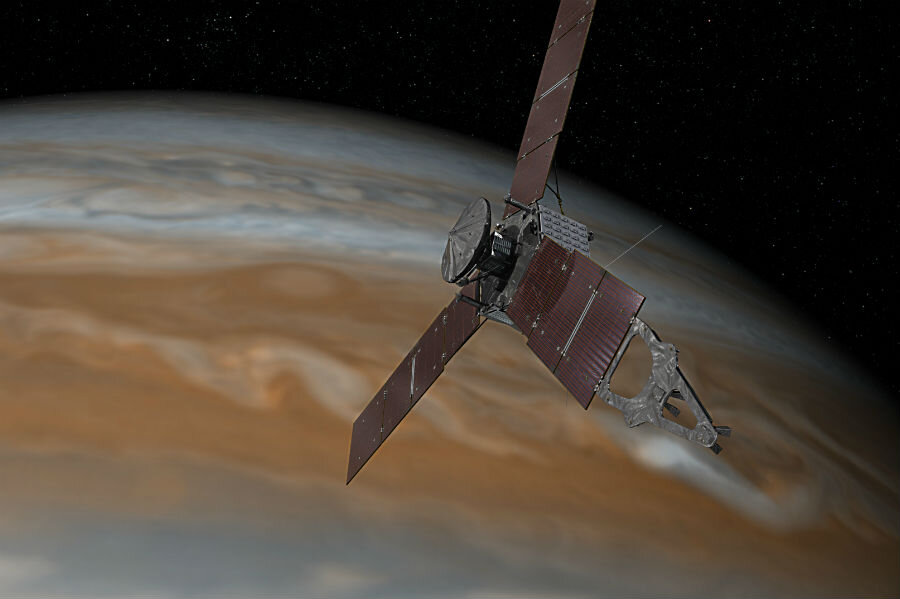Countdown to arrival at Jupiter: What will Juno find?
Loading...
NASA’s Juno mission is now less than one month from its final destination, Jupiter. On July 4, the spacecraft is due to enter a polar orbit around the most massive planet in our solar system.
Juno seeks to unlock the origins and evolution of Jupiter, which will shine a light into the earliest days of our solar system while giving scientists vital insights into the life of giant planets in general, assisting their efforts as they identify and examine Jupiter’s cousins across the universe.
"We're currently closing the distance between us and Jupiter at about four miles per second," said Scott Bolton, Juno’s principal investigator from the Southwest Research Institute in San Antonio, Texas, in a NASA press release. "But Jupiter's gravity is tugging at us harder every day and by the time we arrive we'll be accelerated to 10 times that speed – more than 40 miles per second (nearly 70 kilometers per second) – by the time our rocket engine puts on the brakes to get us into orbit."
Juno’s journey began in August 2011, when it blasted off from Cape Canaveral, Fla., to begin its five-year, 400-million-mile journey. Loaded with eight instruments to peer into a plethora of the planet’s characteristics, including its gravitational field, magnetic field, atmospheric composition and intense auroras, it is the first mission dedicated to the study of Jupiter’s interior.
The spacecraft's name honors the Roman goddess Juno, wife to the lord of the gods, Jupiter. As mythology tells it, Jupiter traced a veil of clouds about himself to hide his mischief, but Juno pierced through the shroud with her gaze and saw Jupiter’s true nature.
Like its namesake, Juno the spacecraft will peer beneath the thick clouds of the solar system’s largest planet to uncover secrets of Jupiter's formation and current conditions. To achieve this, Juno will make repeated approaches to within a few thousand miles of the uppermost puffs of cloud, exposing itself to harsh radiation.
"We have models that tell us what to expect, but the fact is that Juno is going to be immersed in a strong and variable magnetic field and hazardous radiation, and it will get closer to the planet than any previous orbiting spacecraft," said Dr. Bolton in an earlier press release. "Juno's experience could be different than what our models predict – that's part of what makes space exploration so exciting."
Jupiter is composed largely of hydrogen and helium, just like the sun, leading scientists to suppose that it, too, was born in the early days of our solar system, capturing material left over from the birth of our star. Because of the planet’s enormous mass, it may have retained its original composition, unlike Earth, providing an opportunity to peer into the past.
Juno will measure atmospheric water and ammonia, and explore the colorful zones and belts that litter the planet’s surface, examining variations in atmospheric composition, temperature, clouds, and patterns of movement, and analyzing Jupiter’s structure in unprecedented detail.
The mission also seeks to confirm whether Jupiter does indeed have a solid core, as many scientists have modeled.
The spacecraft will also measure Jupiter’s magnetosphere, responsible for the brightest auroras in our entire solar system. They periodically flare with such ultraviolet violence at the poles that, could you stand on Jupiter itself and observe them, "they would appear brighter than the sun itself, even during the day," as Will Dunn, a PhD candidate at University College, London, told The Christian Science Monitor earlier this year.
Mr. Dunn is one of many astronomers who have been laying a solid foundation for the Juno mission, establishing a groundwork of data and statistics using Earth-based telescopes, NASA’s Hubble Space Telescope, and data from Galileo, NASA's hugely successful mission that orbited Jupiter from 1995 to 2003.
As Juno completes its 32 orbits over a period of 20 months, scientists are hoping it will enrich their existing information with mountains of far more detailed measurements.
When Juno's mission comes to a close, after its five-year journey and almost two years of orbiting our solar system’s giant, what will become of the hardy spacecraft?
The answer, according to NASA’s mission timeline, is "deorbit into Jupiter."
“After orbiting Jupiter for over a year, the Juno craft will dive deep into the atmosphere and burn up,” explains a NASA video. “But the mission will never truly end. No matter how many answers we find, there will always be more questions.”








